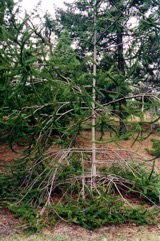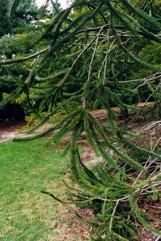Norway spruce, Common spruce

It is a temperate plant. It is frost hardy. It is fast growing. It will grow on most soils. It needs full sunlight. It is cultivated in China. It grows in upland sites in Asia, In Hobart Botanical gardens. It grows between 1000 and 2300 m altitude in Northern Europe. It suits hardiness zones 2-9. Arboretum Tasmania.
Also known as:
Homarika, Kuusk, Lucsika, Navadna smreka, Ou zhou yun shan, Sapin, Smrca, Vagne
Synonyms
- Pinus abies L.
- Picea excelsa Lamarck (1778)not Wallich ex D.Don (1828) Picea excelsa (Lamarck) Link.
Edible Portion
- Flowers, Inner bark, Seeds, Tea, Shoots, Resin, Gum
Where does Norway spruce grow?
Found in: Albania, Australia, Austria, Balkans, Belarus, Bosnia, Britain, Bulgaria, Canada, China, Czech Republic, Estonia, Europe, Finland, France, Germany, Hungary, India, Ireland, Italy, Korea, Lithuania, Luxembourg, North America, Norway, Poland, Romania, Russia, Scandinavia, Slovenia, Sweden, Switzerland, Tasmania, Ukraine, United States, Yugoslavia
Notes: There are between 30 and 45 species of Picea.
Status: The shoots are foraged and eaten in restaurants in Sweden.
Growing Norway spruce, Common spruce
Cultivation: Plants are grown from seed.
Edible Uses: Spruce beer is made from the twigs. Spruce bands are put around cheese to impart flavour. The young shoots are eaten raw covered with sugar to make syrup as a children's snack. The male flowering shoots are eaten raw as a snack and famine food. The young cones are eaten as a famine food and used for a herbal tea.
Production: It is fast growing.
Nutrition Info
per 100g edible portion| Edible Part | Energy (kcal) | Protein (g) | Iron (mg) | Vitamin A (ug) | Vitamin c (mg) | Zinc (mg) | % Water |
|---|---|---|---|---|---|---|---|
| - | - | - | - | - | - |
Norway spruce, Common spruce Photos


References
Abbet, C., et al, 2014, Ethnobotanical survey on wild alpine food plants in Lower and Central Valais (Switzerland). Journal of Ethnopharmacology 151 (2014) 624–634
Ambasta, S.P. (Ed.), 2000, The Useful Plants of India. CSIR India. p 453
Christanell, A., et al, 2010, The Cultural Significance of Wild Gathered Plant Species in Kartitsch (Eastern Tyrol, Austria) and the Influence of Socioeconomic Changes on Local Gathering Practices. Chapter 3 in Ethnobotany in the New Europe. Berghahn Books.
Coombes, A.J., 2000, Trees. Dorling Kindersley Handbooks. p 62
Cundall, P., (ed.), 2004, Gardening Australia: flora: the gardener's bible. ABC Books. p 1039
Deut. Fl. 324. 1881
Denes, A., et al, 2012, Wild plants used for food by Hungarian ethnic groups living in the Carpathian Basin. Acta Societatis Botanicorum Poloniae 81 (4): 381-396
Facciola, S., 1998, Cornucopia 2: a Source Book of Edible Plants. Kampong Publications, p 169
Farrar, J.L., 1995, Trees of the Northern United States and Canada. Iowa State University press/Ames p 108
Fu Liguo, Li Nan, Mill, R.R., Pinaceae. Flora of China.
Harris, E & J., 1983, Field Guide to the Trees and Shrubs of Britain. Reader's Digest. p 232
Hedrick, U.P., 1919, (Ed.), Sturtevant's edible plants of the world. p 494 (As Picea excelsa)
Hibbert, M., 2002, The Aussie Plant Finder 2002, Florilegium. p 232
http://www.botanic-gardens-ljubljana.com/en/plants
Irving, M., 2009, The Forager Handbook, A Guide to the Edible Plants of Britain. Ebury Press p 359
Joyce, D., 1998, The Garden Plant Selector. Ryland, Peters and Small. p 171
Kalle, R. & Soukand, R., 2012, Historical ethnobotanical review of wild edible plants of Estonia (1770s-1960s) Acta Societatis Botanicorum Poloniae 81(4):271-281
Little, E.L., 1980, National Audubon Society Field Guide to North American Trees. Alfred A. Knopf. p 282
Lord, E.E., & Willis, J.H., 1999, Shrubs and Trees for Australian gardens. Lothian. p 85
Łukasz Łuczaj and Wojciech M Szymański, 2007, Wild vascular plants gathered for consumption in the Polish countryside: a review. J Ethnobiol Ethnomedicine. 3: 17
Luczaj, L. et al, 2012, Wild food plant use in 21st century Europe: the disappearance of old traditions and the search for new cuisines involving wild edibles. Acta Soc Bot Pol 81(4):359–370
Luczaj, L., et al, 2015, Wild food plants and fungi used by Ukrainians in the western part of the Maramureş region in Romania. Acta Soc Bot Pol 84(3):339–346
Marinelli, J. (Ed), 2004, Plant. DK. p 147
Pieroni, A. & Soukand, R., 2018, Forest as Stronghold of Local Ecological Practice: Currently Used Wild Food Plants in Polesia, Northern Ukraine. Economic Botany, XX(X) pp. 1-21
Pieroni, A. & Soukand, R., 2017, Are Borders more Important than Geographical Distance? The Wild Food Ethnobotany of the Boykos and its Overlap with that of the Bukovinian Hutsuls in Western Ukraine. Journal of Ethnobiology 37(2): 326–345
Plants for a Future database, The Field, Penpol, Lostwithiel, Cornwall, PL22 0NG, UK. http://www.scs.leeds.ac.uk/pfaf/
Redzic, S. J., 2006, Wild Edible Plants and their Traditional Use in the Human Nutrition in Bosnia-Herzegovina. Ecology of Food and Nutrition, 45:189-232
Schuler, S., (Ed.), 1977, Simon & Schuster's Guide to Trees. Simon & Schuster. No. 26
Shikov, A. N. et al, 2017, Traditional and Current Food Use of Wild Plants Listed in the Russian Pharmacopoeia. Frontiers in Pharmacology. Vol. 8 Article 841
Soukand, R., et al, 2017, Multi-functionality of the few: current and past uses of wild plants for food and healing in Liubań region, Belarus. Journal of Ethnobiology and Ethnomedicine (2017) 13:10
Svanberg, I., 2012, The use of wild plants as food in pre-industrial Sweden. Acta Societatis Botanicorum Poloniae 81(4): 317-327
Svanberg, I. et al, 2012, Uses of tree saps in northern and eastern parts of Europe. Acta Societatis Botanicorum Poloniae 81 (4): 343-357